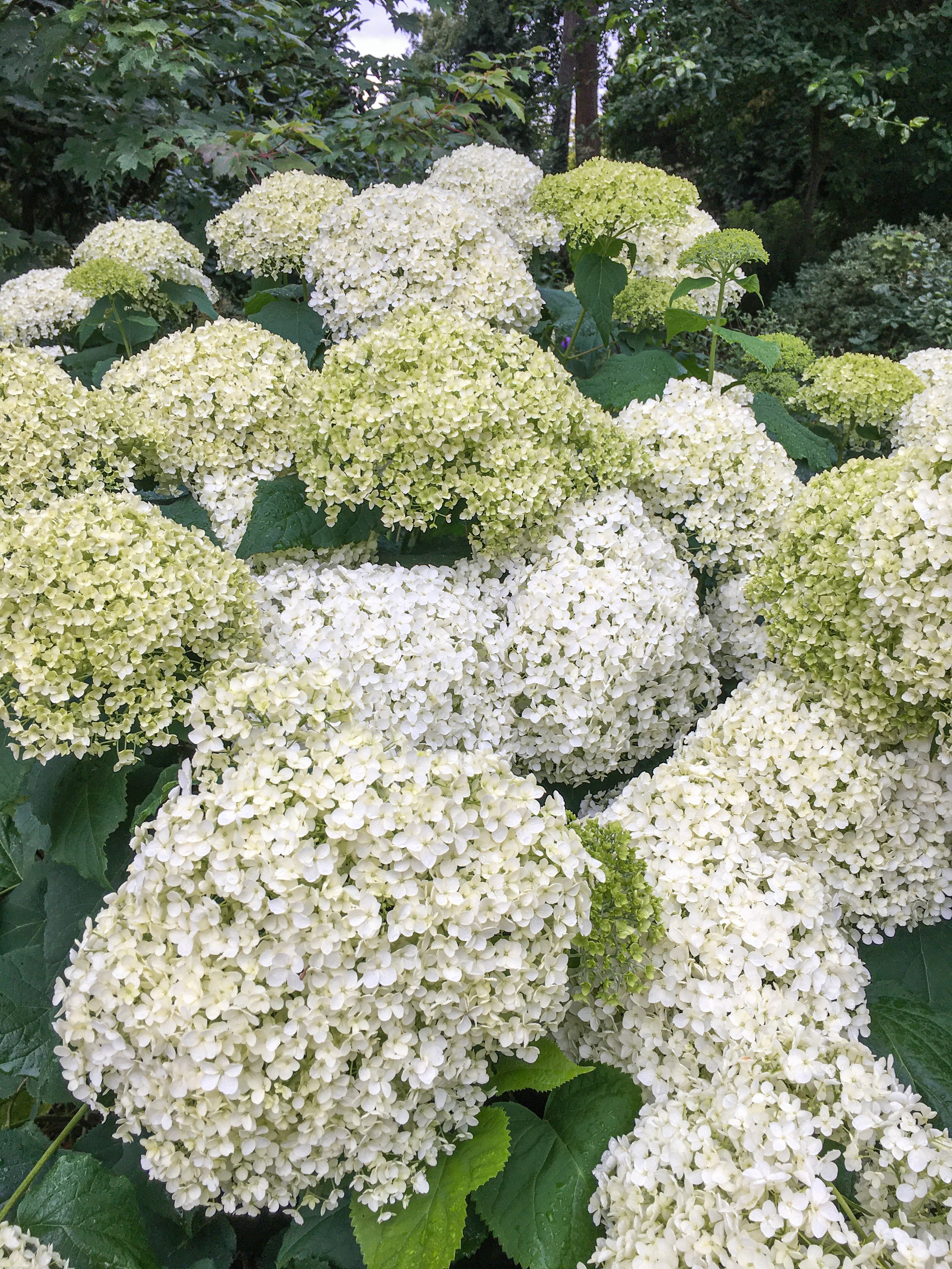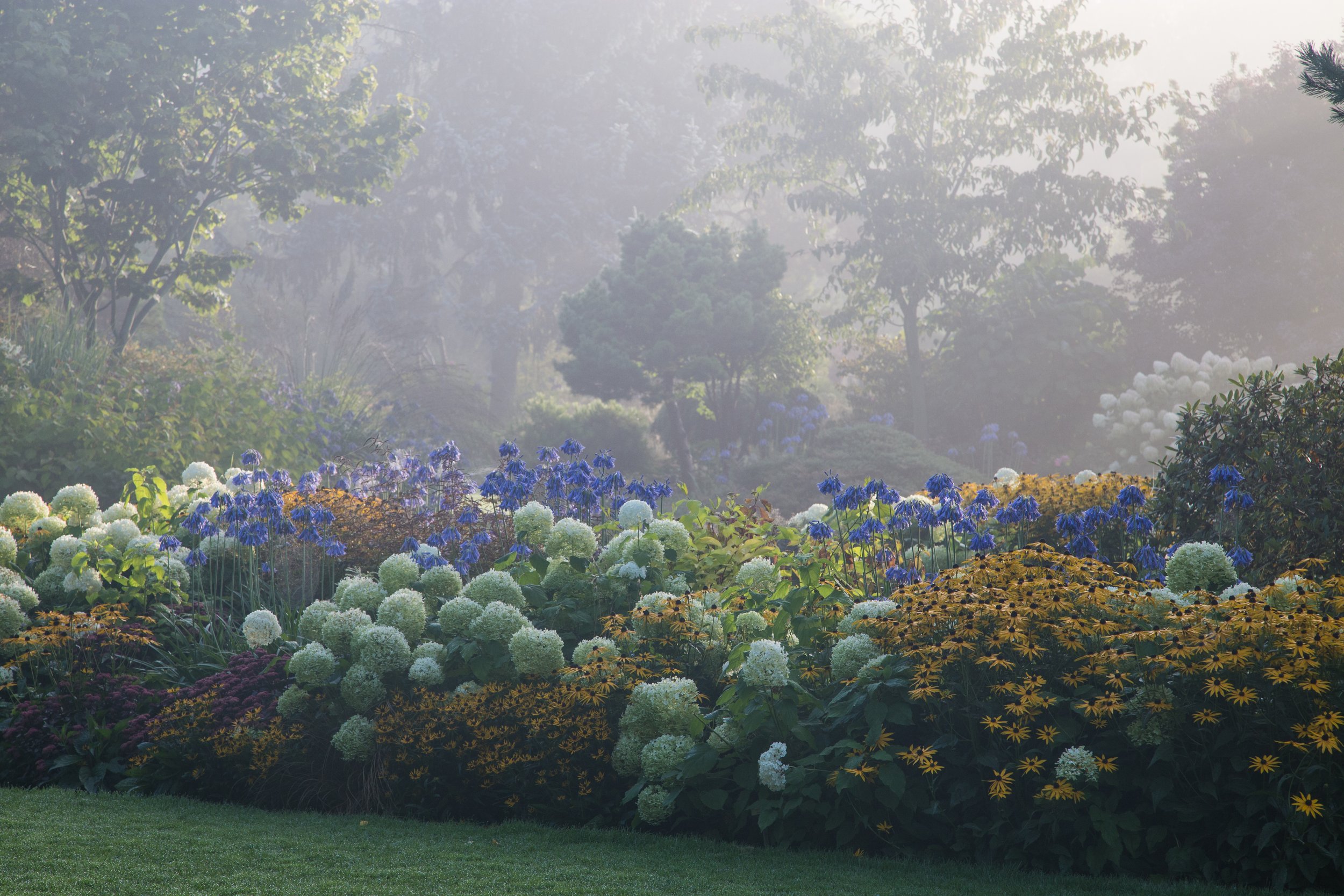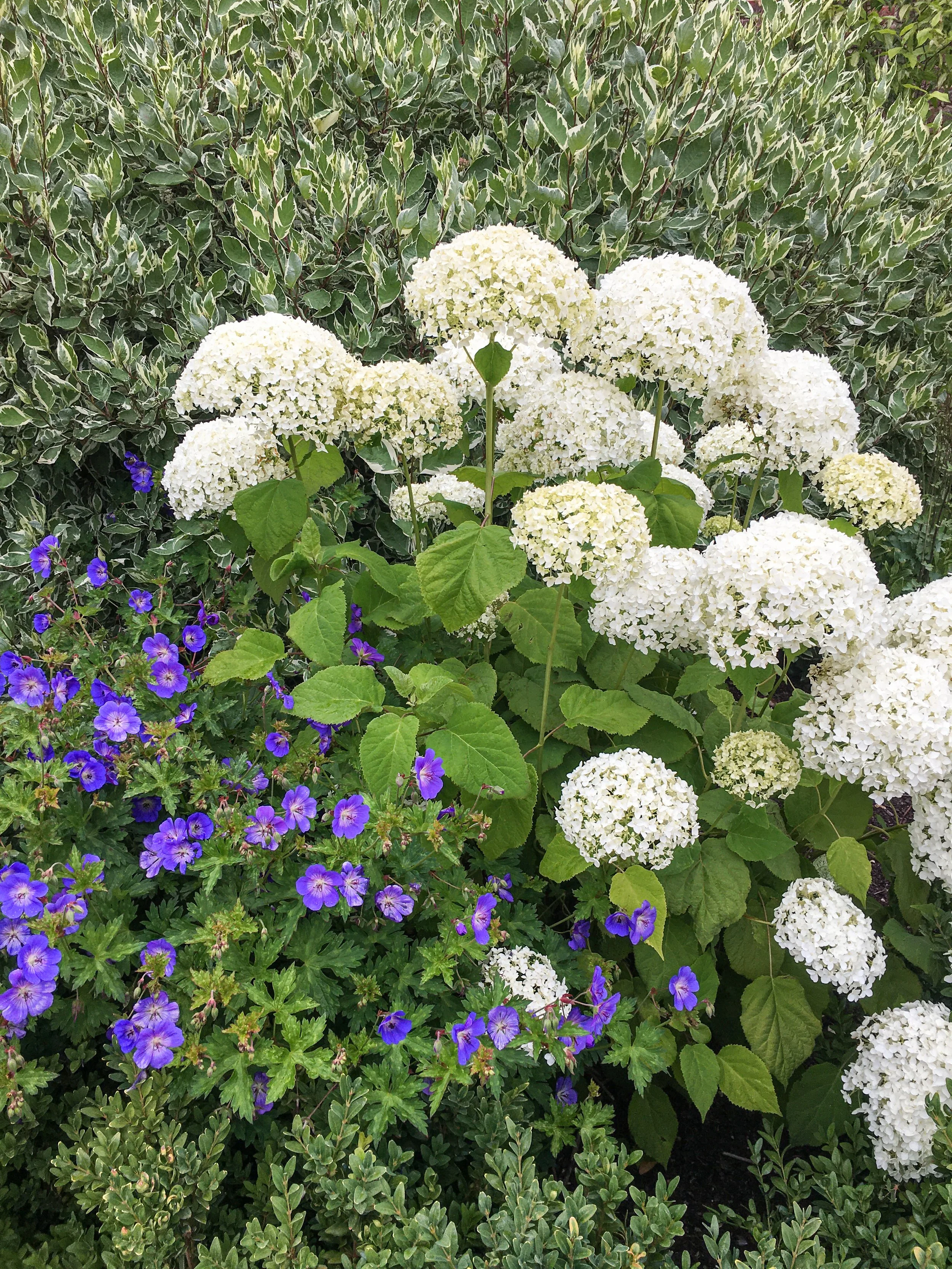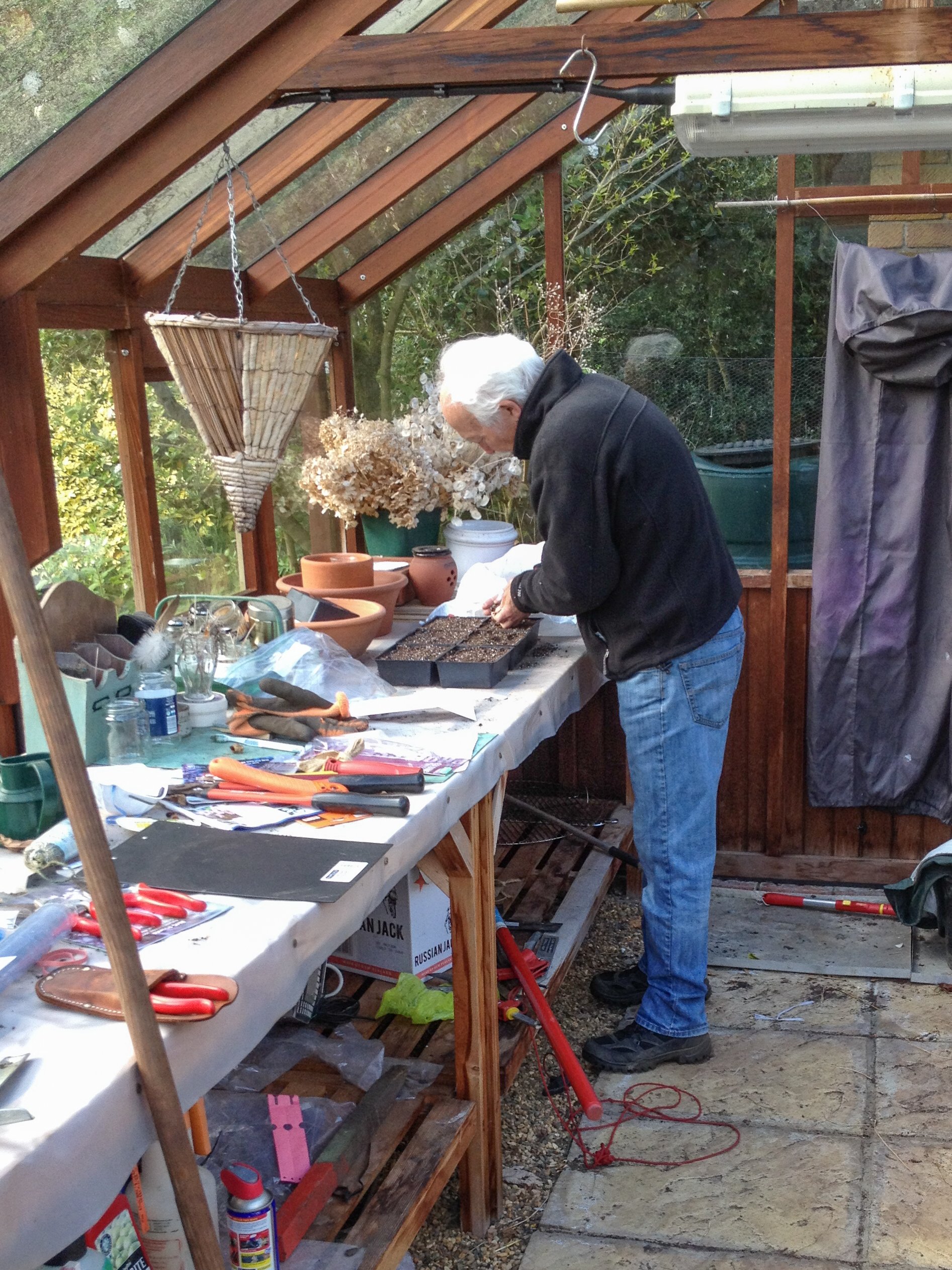Hydrangea arborescens 'Annabelle'
The full unexpurgated story.
This article by Adrian Bloom appeared in the RHS Plant Review in 2022
Hydrangea arborescens Annabelle. It is a shrub that has almost crept up on us, so much so that many gardeners have seen it as a new plant. I suspect this is partly because for a great many years the Hydrangea market and garden media interest has been focussed on the often spectacularly coloured Hydrangea macrophylla hybrids, the ‘Mop heads’ and ‘Lace caps’ of the Hortensias. Mystery and confusion and often failure in performance in these Asian plants had been experienced by many gardeners, since many of the same cultivars were and are used for pot culture for indoor or conservatory use. Questions inevitably arose, “How do you get them so blue?”, “Are they really hardy?”, and constantly, “When should I prune my hydrangeas, and what do I do?”.
Regrettably perhaps, this article is heading in a different direction and has no space or purpose to respond to those seemingly straight forward questions whose answers are seldom so!
But how a good plant (or any plant) gets its name has always been of interest to me, and even more so when it has become such a plant of such universal use. So, as I have explored the origins of Hydrangea arborescens Annabelle over many years, I am pleased share in uncovering some of the layers that disguise the history of this showy shrub. All may not be as it seems…


IN THE BEGINNING
The species originates from eastern North America, growing widely in woodland from New York State to Georgia. The descriptive Latin name arborescens had me fooled for a start, as this species had no likeness or stature of a tree. Seldom will this deciduous shrub reach more than 180cm/ 6ft. Exaggerations in initial naming is not uncommon… think of Tree Peony. The introduction of Hydrangea arborescens to the horticultural world was made as long ago as 1736 by Peter Collinson, an Englishman, quaker and friend of Ben Franklin... but descriptions from others whose knowledge is better informed and up to date is useful. Better still to quote someone who happens to live close to where the species exists as an ‘understory plant’ and are as observant as horticulturist Dr. Michael Dirr, well known plantsman, and Hydrangea breeder. Forthright as ever he says of the species “To witness this species is to wonder how it could ever be a popular garden plant” and “Plants in the wild are often loose and open in habit”, but he also says given better, fertile conditions they improve considerably, becoming denser and more mounded in habit. There is a detailed botanical description of the species in Trees and Shrubs Online attributed to W.J.Bean, but in layman terms, most have flattish heads with flowers a rather dull white ( See images )
Hardiness to Zone 3 in the US is certainly a virtue, as is the fact that, as with the increasingly popular Hydrangea paniculata cultivars, flowers appear on the same years growth so spring frosts, which so often damage the flower buds of “Common Hydrangea” H. macrophylla, is seldom an issue. Until they have grown it British gardeners, used to only thinning out the Hortensis, are very wary about cutting back the whole plant of Hydrangea Annabelle to the ground each spring.


Myth or Memory
When you look at Hydrangea arborescens Annabelle with its enormously showy white heads it is difficult to believe that it arose as a chance seedling in the ‘wild', it certainly was a spectacular find amongst some fairly ordinary neighbours, the common species.
There are two stories told, and both probably link;
First an excerpt, perhaps in unusually flowery language, from an article by the Times gardening writer Stephen Anderton a few years ago, “Meet Annabelle. Once she was seen only in the corner of collectors’ gardens, but now she is the star of the hydrangea world, a floral supermodel.” “Botanists first found Annabelle growing wild near the Us town of Anna in Ohio in the early 1700s.” That is probably a reference to Peter Collinson finding the species ( not Annabelle ) in 1736.
Second is an interpretation close to legend, published more than once but going back to the source, local Anna and region newspaper the Gazette- Democrat. The report of Annabelle’s discovery started;
“according to the ‘Legend of Annabelle’, Harriet Kirkpatrick of the famous pottery family and her daughter Amy (another story is that it was Harriet’s daughter in law) were out horseback riding when they discovered (what was eventually to be named) Annabelle in 1910. They returned later to dig them (it?, probably if it was an old a spreading clump) to put them in their yard (as many will know this is often the American word for garden). As they multiplied, they generously (generously perhaps, but Annabelle wasn’t really theirs!) shared them with friends and neighbours.” Note …the comments in brackets are mine. Nice story whoever Amy was…
From Yard to Nursery
About 50 years later, horticulturist and plant breeder Bon Hartline of Anna noticed this spectacular flowering, and as yet unnamed, Hydrangea as something special and drew it to the attention his former University of Illinois Professor Dr. J. C. McDaniel, who visited Anna and started trialling and propagating it, identifying it as belonging to the species Hydrangea arborescens.


What’s in a name?
The initial suggestion from plantsman Dr. Joe McDaniel for a name (according to some) was Ballerina, which didn’t seem to represent the plant. And we still have a conundrum over Annabelle. I had more romantic visions of it being named after a beautiful lady called Annabelle, but it seems it was named after the town. How Belle was Anna at that time? Or was it, as someone has suggested, named for the ladies of Anna, Belles of Anna? (In which case shouldn’t it have been named Annabelles?). The last information has little to do with the plant, but today’s population of the town of Anna is around 45,000, and at least in horticultural circles Hydrangea Annabelle is a not just a home grown celebrity but grown worldwide. It has also been suggested that the plant, if named after the town, would be much better as Anna Belle, but sensible as this seems, this is purely academic, as we are already 60 years too late.
So, the introduction to the US nursery trade began in 1962 with plants from Dr. McDaniel and little fanfare in the and gradually became known as a unique Hydrangea for American gardens. And the gardeners of Anna now celebrate an Annabelle Day each year on the second week in June. The obvious questions might be … Firstly does everyone in Anna know about Annabelle and secondly…..How many gardens in Anna have an Annabelle planted in them?
There was another memory jogger for me. On researching in a book on Hydrangeas (Timber Press 2004), by nurserymen, father and son Dick and Cor van Gelderen, there was this entry for Hydrangea Annabelle “This plant was found by J.C. McDaniel in Illinois. It is now a very popular cultivar, produced in quantity. RHS Award: A.M.1978, A.G.M.1992. Raised by Gulf Stream Nursery, United States before 1975.” Of course, this description was based on erroneous information, but knowing that Jaques Legendre’s Gulf Stream Nursery supplied many new plants to the then famous mail order company, Wayside gardens, then based in Mentor, Ohio, I remembered where I had first come across Annabelle.
It’s a great story, but what about the plant, the species and the plants that have derived from it?
Hydrangea arborescens Annabelle as a garden plant.
Without a question of doubt, I would put Hydrangea Annabelle as one of the best shrubs of all time. That is a bold statement, but being one of those early collectors, and having gardened with Annabelle for over 30 years, I have come to value it’s long and diverse season of interest.


Hydrangea arborescens Annabelle as a garden plant.
Without a question of doubt, I would put Hydrangea Annabelle as one of the best shrubs of all time. That is a bold statement, but being one of those early collectors, and having gardened with Annabelle for over 30 years, I have come to value it’s long and diverse season of interest.
Its main dislike is being too dry, although it will put up with even that for a time if grown in half shade. Annabelle soon exhibits drooping leaves if under stress during the growth period.
Starting at the beginning of spring as tight green shoots appear on the previous years stems, I cut to the ground, or at least to all woody stems shooting or not. Cutting back can be done earlier too before new shoots appear.
After a slow start the spring growth rate seems phenomenal, shoots bursting into bright green leaves and by June the first lacy green flower heads are starting to appear amongst the developing lime green stems. This is the promise of a summer long display of enlarging flowers which develop into round white balls, as much as 30 cm./ 12ins. diameter. August and September are the most dramatic, and a plant or clumps of plants are eye catching from a distance. Even as early blooms turn to a ripening green, new flowers are appearing, too late but still willing to perform at a lower level. Allow the flowers to turn brown, then a lighter beige, heads can be cut for indoor arrangements, those outside reacting to the vagaries of winter well into the new year. Few deciduous shrubs could match the impact and longevity of interest Hydrangea Annabelle offers through a gardener’s year. Few plants are perfect and it’s a personal view as to whether the rather lax habit, with balloon -like flower heads arching, sometimes to the ground is an attribute or a fault.
Stronger stemmed selections are now on the market. I suspect that the first named H. a. Incrediball/Incredibelle didn’t alert gardeners that this was a different form, so the name was changed to a practical but unimaginative ‘Strong Annabelle’ (Abetwo). I have grown this plant for a few years. It has its place, but I like better the informality of Annabelle as a garden plant. Unlike Annabelle, ‘Strong Annabelle’ is a patented plant and strongly promoted. It is also much more easily grown, handled, and displayed on a garden centre, and in this area the laxer habited Annabelle itself is difficult, seldom looking at its best when in full flower or even before. There are now other forms available and undoubtedly more in the pipeline some with pink flowers, others more lace capped. Once again it seems a little puzzling to name one of the first and best pink flowered forms, H.a. Invincible Spirit which gives no clues of the colour of the flowers, which are much smaller than Annabelle, but whose inflorescences develop into a distinct crushed strawberry pink. Although the deeper pink selection bred by Michael Dirr in Georgia, USA in 2010, Bella Anna, seems not yet available in the UK, it will certainly have a place in gardens. Some of the other pinks I have seen are not outstanding in colour or habit.
Definitely different is Haye’s Sunburst, found in a garden in Alabama. This makes a fairly compact bush with small heads of delicate double white florets that look good from summer well into autumn, although it still doesn’t have the impact of Annabelle.


A Wild Discovery… the triple A story.
I was very fortunate to have a few days in spring in 2016 visiting nurseries, gardens and some native habitats in Georgia and North Carolina with old friends Mike and Bonnie Dirr.
Spring flowers, native Trilliums and many others were in flower, deciduous native Azaleas, and only a suspicion of leaves emerging on the trees and understory shrubs. One day driving along a twisting hillside road, Mike at the wheel, we spotted a vibrant yellow leaf on a Hydrangea which was almost certain to be an arborescens. As we passed to exclamations of excitement, the brakes went on as we re-circled and returned to the spot we had just passed. It was a hydrangea, and the leaf emerging was a definite yellow. An exciting moment for, as far as we knew, a golden leaved Hydrangea arborescens did not then exist. Mike expertly collected seed that remained on last year’s flowers, both of us believing that at least one if not more of those seedlings might have yellow foliage. Dr Michael Dirr had worked for 10 years hybridising from Hydrangea arborescens Annabelle, successfully raising a pink flowered form ‘Bella Anna’.
Needing a secret denomination between us, we settled on the simplification of the American Automobile Association, AAA which meant something to us both. Triple A had to be a bit special! I brought back some seed and both of us sowed the seeds within a week or so. And waited with some anticipation rather than expectancy, which was as well, for although there was a good germination, the young seedlings were a sea of green with no yellow amongst them. I potted several on, not having time to do them all. Perhaps one might turn yellow as it grew… and conversing later by phone it was suggested, perhaps the second generation (seed from some of the AAA’s) might be yellow.
What the experience taught me was that Hydrangea arborescens germinated very well with no competition, and secondly that nature doesn’t always oblige. But now at least I had plants of some native H. arborescens to plant in the nearby Adrian’s Wood devoted to north American origin plants…and more importantly to compare with Hydrangea Annabelle.
Ironic perhaps that I already had noticed for a few years some yellow marking on the leaves of an Hydrangea Annabelle in Foggy Bottom. This was most evident in spring, not very attractive, and I had always put it down to a cultural reaction from the surrounding soil. Some of the seedlings I had sown now exhibited a slightly yellow leaf in the spring.
Two questions arise … the first, is there a tendency for Annabelle to have a golden leaf tinge in spring. The second question is, would a yellow or golden leaved form be desirable to gardeners anyway? Well, if someone comes across one, I’d at least give it a trial…
Third question and last. I am no botanist, but might the very different Annabelle belong to a sub-species since nearly all of the seedlings seem to be clump forming and don’t seem to share the spreading habit
